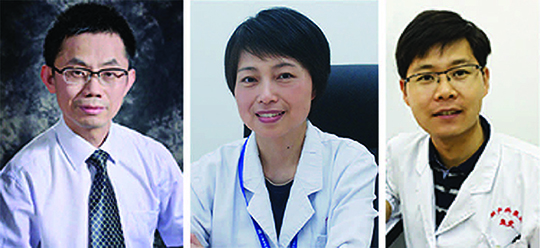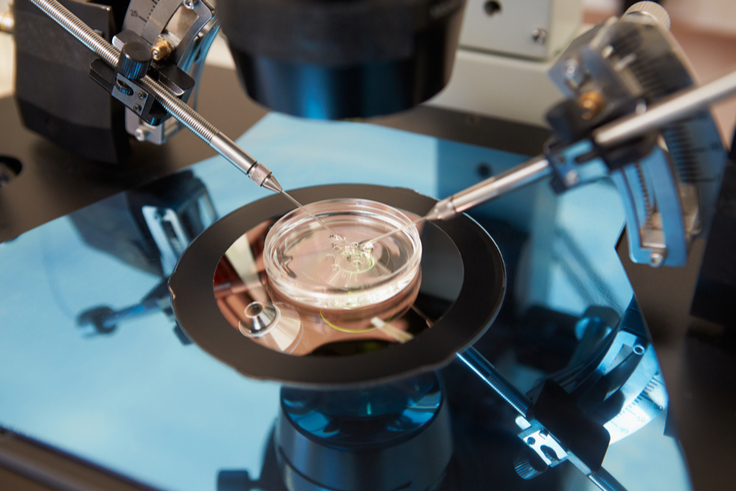SNP Array Identifies Inherited Genetic Disorder Contributing to IVF Failures
Introduction
In January 2016, Shanghai Ji Ai Genetics and IVF (GIVF) Institute became the first institute in China to see the birth of a baby conceived using karyomapping and in vitro fertilization (IVF). Karyomapping is an advanced preimplantation genetic diagnosis (PGD) technique that assesses an embryo for a specific single-gene condition before transfer into the uterus. The goal is to minimize the risk of couples carrying a known inherited genetic disorder of having children affected with that disorder.
Of the known inherited genetic disorders, balanced translocations, including reciprocal and Robertsonian translocations, impact 0.19% of the general population, but its prevalence increases to 2.2% in IVF patients who have a history of recurrent miscarriages or repeat IVF failures.1 Balanced translocations vary from single-gene disorders. Carriers possess a balanced form of the rearrangement and suffer from no health issues.
Current PGD technologies, such as modified fluorescent in situ hybridization (FISH) and next-generation sequencing (NGS) approaches, are time consuming and can’t distinguish between embryos with balanced and structurally normal chromosomes, and reciprocal and Robertsonian translocation carrier.2-4
In 2017, researchers at Shanghai Ji Ai decided to test the ability of karyomapping to detect the presence of balanced translocations. They performed a blinded clinical study of 11 translocation families undergoing IVF using the Human Karyomap-12 Array.5 All families had a history of recurrent spontaneous abortion, infertility, or pregnancies with chromosome abnormalities
iCommunity spoke with several members of the Shanghai Ji Ai team, including Professor Sun Xiao-xi, President of Shanghai Ji Ai; Professor Zhang Yueping, Director, Genetics Department; and Zhang Shuo, Senior Technician of Preimplantation Genetic Diagnosis, about this study and the value of preimplantation genetic haplotyping (PGH) in identifying translocations and limiting their transmission to offspring.

Professor Sun Xiao-xi, President; Professor Zhang Yueping, Director, Genetics Department; and Zhang Shuo, Senior Technician of Preimplantation Genetic Diagnosis at Shanghai Ji Ai Genetics and IVF Institute in Shanghai, China.
Q: What is the incidence of congenital birth defects and genetic disease in China?
Sun Xiao-xi (SX): Our country has a high incidence of congenital disorders. An estimated > 1 million children are born each year with birth defects in China, approximately 5.6% of the total number of births.6 It has seriously affected the quality of life and health of our children and impacted their families and the general community. The leading causes of birth defects are complex and chromosomal diseases. Through karyomapping, we hope to assure IVF parents that their children will be born without known congenital anomalies.
Q: How did your lab identify balanced translocation cases initially and what were the difficulties?
Zhang Shuo (ZS): Prior to the development of our PGH method, we used FISH to analyze embryos from balanced translocation patients, which was time consuming. Faster technologies, such as SNP arrays, analyze only chromosome copy number variations (CNV) and therefore cannot be used to detect chromosome structure abnormalities in diploid embryos.
As a result, diagnosis of transplanted embryos for balanced translocations is difficult. That’s a problem for IVF patients who are carriers. There is the potential that their child will possess an unbalanced translocation and will be born with congenital defects. There is also a 50% probability their embryos could be carriers of the same chromosome translocation that they possess, increasing the risk of transferring a detrimental allele to subsequent generations.
"The HumanKaryomap-12 Array enables simultaneous analysis of molecular haplotypes and aneuploidy screening."
Q: How did you develop your new PGH method?
ZS: We theorized that whole-genome karyomapping had the potential to diagnose embryos with chromosomal structure abnormalities, such as reciprocal and Robertsonian translocations. Karyomapping uses linkage-based genome-wide haplotyping to provide a high-density view of chromosomes and insight into inherited alleles.
First, we chose the genetic marker type to use in performing a study. Short tandem repeat (STR) loci analysis is a difficult and time-consuming analysis to perform, especially on multiple DNA sources (family members and embryos). We chose SNPs as our genetic marker, which offer a faster, streamlined workflow. With SNPs, we can perform linkage analysis between parents, reference samples, and embryos easily. We researched the various SNP-arrays on the market and chose the 300,000 SNP HumanKaryomap-12 Array on the iScan™ System. It enables simultaneous analysis of molecular haplotypes and aneuploidy screening for each embryo and includes easy-to-use BlueFuse™ Multi Software for data analysis.
Q: How did you decide which SNPs to use in detecting balanced and structurally normal translocations?
ZS: We identified informative SNPs that were used to establish the haplotypes (DNA variations inherited together). For our study, the haplotypes consisted of the breakpoint regions, the whole chromosomes involved in the translocations, and the corresponding normal homologous chromosomes in the couple, reference (a family member or an unbalanced embryo), and the embryos.
The selection criteria were that the SNPs should be heterozygous in the carrier, homozygous in his/her partner, and homozygous in the carrier’s parents or other family members. This information was used to determine which of the carrier’s two haplotypes were linked to the derivative chromosome or the normal chromosome. The predictive criterion to distinguish embryos with balanced and structurally normal chromosomes combined the haplotypes of breakpoint regions and the presence of homologous recombination in those regions.
"Our method can identify haplotypes in chromosomes or breakpoint regions genome wide to identify the presence of any type of translocation."
Q: Describe the PGH process used to perform balanced translocation analysis?
Zhang Yueping (ZY): The process involves genome-wide SNP genotyping with the Human Karyomap-12 Array of DNA samples from the IVF couple, their parents, and embryos. We use BlueFuse Multi Software to perform linkage analysis and model the patient family genome-wide haplotype. If the carrier’s balanced translocations were inherited, building the family haplotype requires analyzing the DNA of a close family relative to use as a reference. If it’s a de novo family mutation, we use an embryo with an unbalanced translocation as the reference.
Q: What were the results of the study testing the ability of this PGH method to identify balanced and structurally normal embryos?
ZS: Eleven translocation families were enrolled in the study. In addition to the prospective parents and certain close relatives, 68 blastocysts were analyzed in which 42 were unbalanced and 26 were balanced. We identified 13 embryos with structurally normal chromosomes and these were transferred back into the corresponding IVF patients. Prenatal cytogenetic analysis of amniotic fluid cells was performed after the second trimester. The results predicted by PGH were consistent with the cytogenetic analysis.
Q: What are the advantages of this new PGH method?
ZS: Our PGH genome-wide haplotype linkage analysis method has several advantages. It identifies the haplotypes in the breakpoint regions. It detects homologous recombination in the breakpoint regions by simultaneously identifying the haplotypes of the two whole chromosomes involved in the translocation and the two corresponding normal homologous chromosomes. It provides information to improve the clinical pregnancy rate by determining which embryos are translocation carriers and screening all chromosomes for aneuploidy, simultaneously. Finally, our method can identify haplotypes in chromosomes or breakpoint regions genome wide to identify the presence of any type of translocation.
Most importantly, our PGH method is relatively simple and efficient, and suitable for routine clinical application. The entire process can be completed within 48 hours, with data analysis taking less than two hours of the total time.
"Most importantly, our PGH method is relatively simple and efficient, and suitable for routine clinical application."
Q: Do you now perform karyomapping for every embryo sample?
ZY: For the past few years, we used the HumanKaryomap-12 Array to identify only single-gene defects of embryo biopsies. We now use it on all potential IVF embryos to identify single-gene defects and structural chromosomal abnormalities, such as translocations.
Q: What is the significance of this breakthrough in the detection of balanced translocation IVF patients for clinical diagnosis?
SX: China has millions of seemingly healthy chromosome balanced translocation patients with the potential of passing along the chromosome abnormality to subsequent generations. Development of this genome-wide haplotype linkage analysis technology is an important breakthrough in the field of human-assisted reproductive medicine in our country and demonstrates our leadership in the field. It improves the success of IVF treatments, particularly in patients who have suffered from recurrent miscarriages. For balanced translocation patients, the technology ensures that they won’t pass the translocation chromosomes they possess along to their offspring.
Learn more about the products and systems mentioned in this article:
References
- Zhang S, Lei C, Wu J, et al. The establishment and application of preimplantation genetic haplotyping in embryo diagnosis for reciprocal and Robertsonian translocation carriers BMC Med Genomics. 2017; 10(1):60. doi: 10.1186/s12920-017-0294-x.
- Weier HU, Munn S, Fung J. Patient-specific probes for preimplantation genetic diagnosis of structural and numerical aberrations in interphase cells. J Assist Reprod Genet. 1999; 16:182−191.
- Lersch RA, Fung J, Munné S, et al. Case-Specific, Breakpoint-Spanning DNA Probes for Analysis of Single Interphase Cells. Genet Test. 2000; 4:273−278.
- Hu L, Cheng D, Gong F, et al. Reciprocal Translocation Carrier Diagnosis in Preimplantation Human Embryos. EBioMedicine. 2016; 14:139−147.
- Alfarawati S, Fragouli E, Colls P, et al. First births after preimplantation genetic diagnosis of structural chromosome abnormalities using comparative genomic hybridization and microarray analysis. Hum Reprod. 2011; 26:1560−1574.
- Zhao W, Wu M, Chen F, et al. Robertsonian Translocations: An Overview of 872 Robertsonian Translocations Identified in a Diagnostic Laboratory in China. PLoS One. 2015; 10(5): e0122647.
